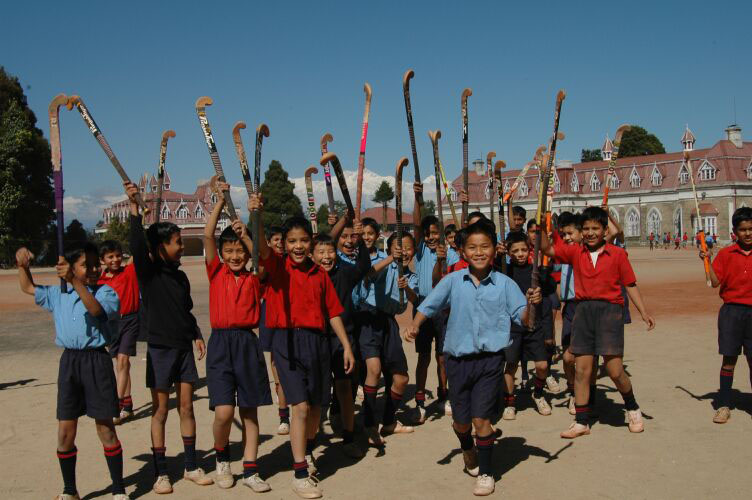★クラスの人数
(How many students are there in a class?) |
私立の場合:20〜25人
(Private-- About 25-30.)
国立の場合:40〜70人(Public--- About 40-70)
|
★英語の先生はネイティブですか?
(When do you start learning English?)
|
Aさんの回答:(私立の場合)ネイティブもいれば、そうでない先生もいます。
Some were native speakers. Others were not.
Bさんの回答:(国立の場合)いいえ、英語の先生はインド人です。ただ、私立の英語の先生のレベルはとても高いです。
No. They are not native speakers but the level of English in the majority of private schools is quite
good.
Cさんの回答:(国立の場合)いません。外国人の先生を呼ぶには、低すぎる給料だから来ないのだと思います。
No. Salaries in India are too low to attract teachers from abroad.
|
★英語の先生はどんな訓練を受けていますか?
(What kind of training do English teachers have to undergo?)
|
インド政府が発行する教員免許が必要です。また、先生同士のシンポジウムを開いて、見交換をする機会もあります。
All teachers need a teaching license from the Indian government. There are occasional
symposiums where teachers in a particular district meet to exchange methodologies, etc.
|
★インドの人々は英語教育に関心はありますか?
(Is there widespread interest in English education?)
|
Aさんの回答:
(私立の場合):高いです。すべての州で教えられている唯一の言葉が英語であり、
14の公用語を持つインドをまとめるのにその役割が果たす力は大きいと思います。
Yes. English helps bind the country as one since India has as
many as 14 official languages with English being the only language that is commonly studied across all regions in
India.
Bさんの回答:国立の場合)大都市ではとても高いです。
毎月 新しい英語の教室がオープンしていることからも、その関心の高さがうかがえると思います。
Definitely yes in the cities. There are many new English education
institutions opening up every month, which is an
indication that there is great demand for English.
|
★英語の塾はありますか?
(Are there cram schools that teach English?)
|
はい、たくさんあります。
Yes. There are many English cram schools.
|
★外国人の生徒や移民はいますか??
(Are there many foreign students?)
|
Aさんの回答:います。
ほとんどがネパール、スリランカ、
ブータン、バングラデッシュ、モルディブやUAE(アラブ首長国連邦)、アフリカ諸国からです。
Yes. Most of them are from Nepal, Sri Lanka, Bhutan,Bangladesh, the Maldives, UAE and some African countries.
外国に住んでいるインド人は多く、その子供たちをインド本国に留学させるケースもよく見られます。
大学になると、さまざまな国からの留学生がたくさんおり、より国際的な顔ぶれになります。
There are many Indians who have settled outside the country but who send their
children to India for their studies. In universities,
there are a lot more international students.
|
★インドの子供たちが英語を習う上での難しさとは?
(What are the difficulties that your country's children face when learning English?)
|
Aさんの回答::教科書に斬新さがなく、視覚に訴えるものもない。
教師のアクセントがあまり良くないこともあるということ。
The textbooks are not very creative and there are not many audiovisual devices. Sometimes
the accent of the teachers isn't very good.
Bさんの回答:
子供たちがとても受け身。ただ先生の言っていることを聞いたりそれに従ったり
することを求められていること。
The students are very passive. They are expected to listen to and obey the teacher.
|
★教育について、インドの社会ではどのようにとらえていますか?
(What are people's attitude toward education generally?)
|
Aさんの回答:インドにおいて
教育はとても大切なことだととらえられていて、学ぶ側も教える側も一生懸命さがあります。
Education in India is treated very seriously,
with both students and teachers putting a great deal
of effort into studying and teaching.
Bさんの回答:
インドでは、教育とは貧困さから抜け出す唯一の方法なのです。ですので、
それが動機付けとなり、人々の関心も高いものがあります。
その一方で、自分の子供たちが働くことで生活の助けとなるため、
学校に行かせることが出来ない親もたくさんいます。法律で定められているにもかかわらずです。
In India, education is the only way for people
to get out of poverty. So people are very motivated and interested in education.
However, many poor people need their children to help them earn a living and cannot
send them to school even though it is legally required.
|
★小学校での英語の授業は何時間ありますか?
(How much time is spent on teaching English each week?)
|
Aさんの回答:国立の学校では、毎日少なくとも45分間あるので、
週に換算して4時間半ぐらいだと思います。(私立では学校によります)
On average, there is at least one class of about 45 minutes
every day so that makes around four-and-a-half hours per week.
|
★日本の英語教育についてどう思いますか。
(What do you think of English education in Japan?)
|
日本の教育自体は、小学校から高等学校までとてもいいと思いますが、
大学は残念ながらとても低いと思います。
ネイティブの先生から習わないので、英語教育は小学校の段階からあまりよくないと思います。
Japanese education is generally very good at the
elementary and high-school level, but very poor at the university level.
But the teaching of English is not so good even at the elementary
level because the teachers are not native speakers of English.
|
★識字率について
(Rate of literacy)
|
Aさんの回答:男性:75.3%
male ⇒ 75.3%
女性:53.7%
female⇒ 53.7%.
全国平均 :64.8%
average in all India:64.8%
Bさんの回答:大都市:約85%
In metro cities⇒around 85%
地方:約25%
In village ⇒around 25%
平均:45%ぐらい
average in all India: Around 45%

|
